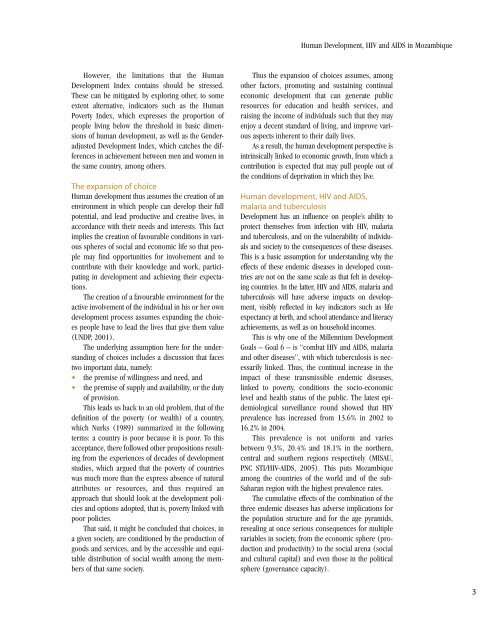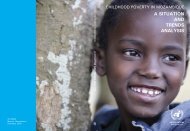English language version - Human Development Reports - United ...
English language version - Human Development Reports - United ...
English language version - Human Development Reports - United ...
- No tags were found...
Create successful ePaper yourself
Turn your PDF publications into a flip-book with our unique Google optimized e-Paper software.
<strong>Human</strong> <strong>Development</strong>, HIV and AIDS in MozambiqueHowever, the limitations that the <strong>Human</strong><strong>Development</strong> Index contains should be stressed.These can be mitigated by exploring other, to someextent alternative, indicators such as the <strong>Human</strong>Poverty Index, which expresses the proportion ofpeople living below the threshold in basic dimensionsof human development, as well as the Genderadjusted<strong>Development</strong> Index, which catches the differencesin achievement between men and women inthe same country, among others.The expansion of choice<strong>Human</strong> development thus assumes the creation of anenvironment in which people can develop their fullpotential, and lead productive and creative lives, inaccordance with their needs and interests. This factimplies the creation of favourable conditions in variousspheres of social and economic life so that peoplemay find opportunities for involvement and tocontribute with their knowledge and work, participatingin development and achieving their expectations.The creation of a favourable environment for theactive involvement of the individual in his or her owndevelopment process assumes expanding the choicespeople have to lead the lives that give them value(UNDP, 2001).The underlying assumption here for the understandingof choices includes a discussion that facestwo important data, namely:• the premise of willingness and need, and• the premise of supply and availability, or the dutyof provision.This leads us back to an old problem, that of thedefinition of the poverty (or wealth) of a country,which Nurks (1989) summarized in the followingterms: a country is poor because it is poor. To thisacceptance, there followed other propositions resultingfrom the experiences of decades of developmentstudies, which argued that the poverty of countrieswas much more than the express absence of naturalattributes or resources, and thus required anapproach that should look at the development policiesand options adopted, that is, poverty linked withpoor policies.That said, it might be concluded that choices, ina given society, are conditioned by the production ofgoods and services, and by the accessible and equitabledistribution of social wealth among the membersof that same society.Thus the expansion of choices assumes, amongother factors, promoting and sustaining continualeconomic development that can generate publicresources for education and health services, andraising the income of individuals such that they mayenjoy a decent standard of living, and improve variousaspects inherent to their daily lives.As a result, the human development perspective isintrinsically linked to economic growth, from which acontribution is expected that may pull people out ofthe conditions of deprivation in which they live.<strong>Human</strong> development, HIV and AIDS,malaria and tuberculosis<strong>Development</strong> has an influence on people’s ability toprotect themselves from infection with HIV, malariaand tuberculosis, and on the vulnerability of individualsand society to the consequences of these diseases.This is a basic assumption for understanding why theeffects of these endemic diseases in developed countriesare not on the same scale as that felt in developingcountries. In the latter, HIV and AIDS, malaria andtuberculosis will have adverse impacts on development,visibly reflected in key indicators such as lifeexpectancy at birth, and school attendance and literacyachievements, as well as on household incomes.This is why one of the Millennium <strong>Development</strong>Goals – Goal 6 – is “combat HIV and AIDS, malariaand other diseases”, with which tuberculosis is necessarilylinked. Thus, the continual increase in theimpact of these transmissible endemic diseases,linked to poverty, conditions the socio-economiclevel and health status of the public. The latest epidemiologicalsurveillance round showed that HIVprevalence has increased from 13.6% in 2002 to16.2% in 2004.This prevalence is not uniform and variesbetween 9.3%, 20.4% and 18.1% in the northern,central and southern regions respectively (MISAU,PNC STI/HIV-AIDS, 2005). This puts Mozambiqueamong the countries of the world and of the sub-Saharan region with the highest prevalence rates.The cumulative effects of the combination of thethree endemic diseases has adverse implications forthe population structure and for the age pyramids,revealing at once serious consequences for multiplevariables in society, from the economic sphere (productionand productivity) to the social arena (socialand cultural capital) and even those in the politicalsphere (governance capacity).3
















